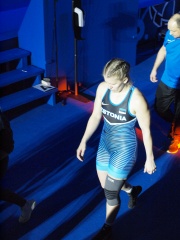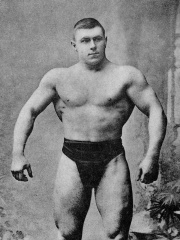
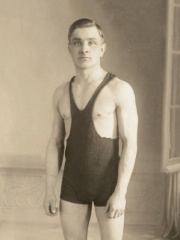
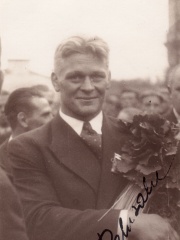
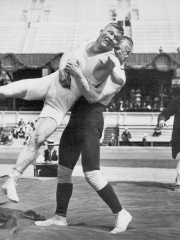
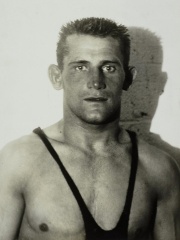
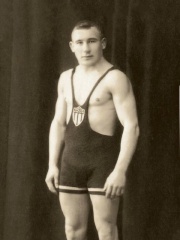
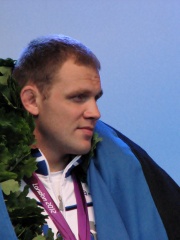

The Most Famous
WRESTLERS from Estonia
Top 10
The following people are considered by Pantheon to be the top 10 most legendary Estonian Wrestlers of all time. This list of famous Estonian Wrestlers is sorted by HPI (Historical Popularity Index), a metric that aggregates information on a biography's online popularity. Visit the rankings page to view the entire list of Estonian Wrestlers.

1. George Hackenschmidt (1877 - 1968)
With an HPI of 65.54, George Hackenschmidt is the most famous Estonian Wrestler. His biography has been translated into 18 different languages on wikipedia.
Georg Karl Julius Hackenschmidt (Russian: Георгий Георгиевич Гаккеншми́дт, romanized: Georgiy Georgiyevich Gakkenshmídt; 1 August 1877 – 19 February 1968), known in English-language publications as George Hackenschmidt, was an Estonian strongman, amateur and professional wrestler, writer, and sports philosopher. He is recognized as professional wrestling's first world heavyweight champion. Hackenschmidt began his professional career in Tallinn (Reval), Estonia (then part of the Russian Empire), and after an 1899 tournament in Paris was often referred in the media by the moniker "The Russian Lion". He lived most of his middle age and later life in London, England, becoming a British subject after the Second World War. He is believed to be the creator of the professional wrestling version of the bear hug as well as the person who popularised the hack squat; additionally, Hackenschmidt is also attributed as the creator of the bench press. He was known for his impressive strength, fitness, and flexibility. Later in life, he wrote many books on physical culture, training and philosophy.

2. Eduard Pütsep (1898 - 1960)
With an HPI of 59.45, Eduard Pütsep is the 2nd most famous Estonian Wrestler. His biography has been translated into 25 different languages.
Eduard Pütsep (21 October 1898 – 22 August 1960) was an Estonian wrestler. He competed in Greco-Roman wrestling in the 1920, 1924 and 1928 Olympics and won a gold medal in the bantamweight division in 1924, becoming the first Olympic champion in wrestling from Estonia. In 1928 he placed sixth in Greco-Roman and ninth in freestyle wrestling.

3. Kristjan Palusalu (1908 - 1987)
With an HPI of 58.37, Kristjan Palusalu is the 3rd most famous Estonian Wrestler. His biography has been translated into 22 different languages.
Kristjan Palusalu (until 1935 Kristjan Trossmann, 10 March [O.S. 26 February] 1908 – 17 July 1987) was an Estonian heavyweight wrestler and Olympic winner. Palusalu became the first and only wrestler in Olympic history ever to win both the Greco-Roman and freestyle heavyweight events. Palusalu was born in Varemurru village, Saulepi Parish, Lääne County (now Matsi village, Lääneranna Parish, Pärnu County) as one of eight children to Jüri and Liisu Trossmann. He is best remembered for winning two gold medals at the 1936 Summer Olympics in Berlin. He was given the honor of carrying the Estonian flag to the Olympiastadion. The triumph was celebrated across Estonia with Palusalu and other Estonian athletes touring the country by rail giving speeches. A third of the inhabitants of Tallinn turned out to greet him and the Estonian government granted him a farm. After the Soviet Union occupied Estonia in 1940, Palusalu was sent to hard labour in Kotlas, Russia in 1941. He tried to escape with other prisoners but was captured after a few days. He was then sentenced to death together with his fellow fugitives but was given the chance to go to the front line to fight against Finland in the Continuation War. He deserted to the Finnish side in Northern Karelia, northwest of Lake Onega. According to one Finnish soldier, Mr. Suuperko, Palusalu and his friends shouted "Finnish boys do not shoot Estonians", when they crossed the lines. Palusalu was soon recognized by a person in the Finnish army, who had sports background (Heikki Savolainen). He was imprisoned, but then was allowed to return to his homeland, which was then under German occupation. After the return of the Soviet army in 1945 he was arrested again, but was later allowed to work as a trainer and a referee, he also participated in some competitions in Estonia. He was not forgotten by the Estonian people. As one of the most popular sportsmen in Estonia throughout history, Kristjan Palusalu is one of the few who have become synonymous with the Estonian nation itself. Palusalu was married to Ellen Saidla. The couple had a son, Jüri Palusalu.

4. Martin Klein (1884 - 1947)
With an HPI of 57.55, Martin Klein is the 4th most famous Estonian Wrestler. His biography has been translated into 18 different languages.
Martin Klein (12 September 1884 – 11 February 1947) was an Estonian wrestler who competed for the Russian Empire at the 1912 Summer Olympics. He won the silver medal in the middleweight class, becoming the first Olympic medalist born in the territory of modern Estonia. In the semi-final against the reigning world champion Alfred Asikainen, the two grappled for 11 hours and 40 minutes on a sunny day outdoors, until Klein managed to pin Asikainen. Klein was so exhausted from the bout – the longest wrestling match ever recorded – that he was unable to wrestle for the gold the next day, leaving Swedish wrestler Claes Johansson with the gold medal.
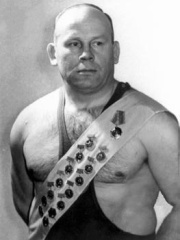
5. Johannes Kotkas (1915 - 1998)
With an HPI of 57.24, Johannes Kotkas is the 5th most famous Estonian Wrestler. His biography has been translated into 19 different languages.
Johannes Kotkas (3 February 1915 – 8 May 1998) was a heavyweight Greco-Roman wrestler from Estonia who won a gold medal at the 1952 Summer Olympics. He held the European title in 1938, 1939 and 1947 and placed second at the 1953 world championships.

6. Voldemar Väli (1903 - 1997)
With an HPI of 56.60, Voldemar Väli is the 6th most famous Estonian Wrestler. His biography has been translated into 20 different languages.
Voldemar Väli (10 January 1903 – 13 April 1997) was an Estonian two-time Olympic medalist in Greco-Roman wrestling.

7. Osvald Käpp (1905 - 1995)
With an HPI of 55.37, Osvald Käpp is the 7th most famous Estonian Wrestler. Her biography has been translated into 20 different languages.
Osvald Käpp (17 February 1905 – 22 December 1995) was an Estonian wrestler who competed in freestyle and Greco-Roman lightweight events at the 1924, 1928 and 1932 Summer Olympics. He won the freestyle contest in 1928 and served as the Olympic flag bearer for Estonia in 1932. He also won two medals in Greco-Roman wrestling at the European championships in 1926–27. Käpp trained as a gymnast and basketball player before changing to wrestling in 1923. In 1929, during the Great Depression, he immigrated to New York City, and won the AAU Greco-Roman (1929) and freestyle titles (1930–31). He retired in 1931, but was convinced to compete in the 1932 Summer Olympics, as Estonia could not afford to send an Olympic team to Los Angeles and was recruiting Estonians living in the United States (only Käpp and Alfred Maasik agreed). Lack of preparation took its toll, and Käpp was eliminated after three rounds in both freestyle and Greco-Roman wrestling. Käpp was a pastry-chef. While living in Tallinn, he worked at a candy factory and later opened a bakery in New York.

8. Heiki Nabi (b. 1985)
With an HPI of 45.14, Heiki Nabi is the 8th most famous Estonian Wrestler. His biography has been translated into 26 different languages.
Heiki Nabi (born 6 June 1985) is an Estonian Olympic champion Greco-Roman wrestler. Nabi was born in Hilleste, Hiiumaa. At the 2006 World Wrestling Championships he won the gold medal in the men's Greco-Roman (96 kg) category and became the first amateur wrestling World Champion for his home country, because previous Estonian wrestling World Champion August Englas (1953 and 1954) competed for Soviet Union. At the 2012 Summer Olympics in London, Nabi won the silver medal in the Men's Greco-Roman 120kg. He competed at the 2024 European Wrestling Olympic Qualification Tournament in Baku, Azerbaijan hoping to qualify for the 2024 Summer Olympics in Paris, France. He was eliminated in his first match and he did not qualify for the Olympics. Nabi also competed at the 2024 World Wrestling Olympic Qualification Tournament held in Istanbul, Turkey without qualifying for the Olympics. However, Nabi received a quota due to reallocations of Individual Neutral Athletes (AIN) claimed by the IOC, garnering him a place on the Estonian Olympic team. He competed in the 130 kg event at the Olympics and finished 10th.

9. Indrek Pertelson (b. 1971)
With an HPI of 45.09, Indrek Pertelson is the 9th most famous Estonian Wrestler. His biography has been translated into 19 different languages.
Indrek Pertelson (born 21 April 1971) is an Estonian former international judoka. At the 2000 and 2004 Summer Olympics he won bronze medals in the men's Heavyweight (+100 kg) category. He has won the gold medal in the 1996 European Judo Championships in the Open class. Pertelson was born in Tallinn.
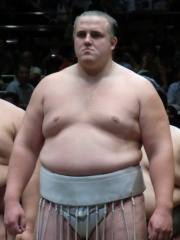
10. Baruto Kaito (b. 1984)
With an HPI of 43.70, Baruto Kaito is the 10th most famous Estonian Wrestler. His biography has been translated into 18 different languages.
Kaido Höövelson (born 5 November 1984), known professionally as Baruto Kaito (把瑠都 凱斗), is an Estonian politician and former professional sumo wrestler. Making his debut in May 2004, he reached the top division after just two years in sumo in May 2006. After suffering a number of injury problems in 2007 which delayed his progress, he reached the third-highest rank of sekiwake in November 2008, and was promoted to ōzeki rank after finishing the March 2010 tournament with a score of 14–1. He was a tournament runner-up four times before recording a top division championship in the 2012 January tournament. During his career Baruto also earned five special prizes for Fighting Spirit, one for Outstanding Performance and one for Technique. He lost his ōzeki rank after more injury problems at the end of 2012, and having fallen greatly in rank after withdrawing from the May 2013 tournament, he announced his retirement in September of that year at the age of 28. After retirement from sumo, Höövelson has been involved in different business ventures, mixed martial arts, acting, and politics. In March 2019 he was elected to the Riigikogu.
People
Pantheon has 12 people classified as Estonian wrestlers born between 1877 and 1992. Of these 12, 5 (41.67%) of them are still alive today. The most famous living Estonian wrestlers include Heiki Nabi, Indrek Pertelson, and Baruto Kaito. The most famous deceased Estonian wrestlers include George Hackenschmidt, Eduard Pütsep, and Kristjan Palusalu.
Living Estonian Wrestlers
Go to all RankingsHeiki Nabi
1985 - Present
HPI: 45.14
Indrek Pertelson
1971 - Present
HPI: 45.09
Baruto Kaito
1984 - Present
HPI: 43.70
Martin Padar
1979 - Present
HPI: 37.55
Epp Mäe
1992 - Present
HPI: 34.71
Deceased Estonian Wrestlers
Go to all RankingsGeorge Hackenschmidt
1877 - 1968
HPI: 65.54
Eduard Pütsep
1898 - 1960
HPI: 59.45
Kristjan Palusalu
1908 - 1987
HPI: 58.37
Martin Klein
1884 - 1947
HPI: 57.55
Johannes Kotkas
1915 - 1998
HPI: 57.24
Voldemar Väli
1903 - 1997
HPI: 56.60
Osvald Käpp
1905 - 1995
HPI: 55.37
Overlapping Lives
Which Wrestlers were alive at the same time? This visualization shows the lifespans of the 7 most globally memorable Wrestlers since 1700.


